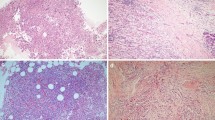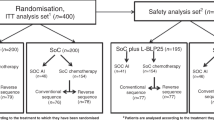Summary:
Several studies have shown conflicting results with the use of intensive consolidation chemotherapy for breast cancer. The aim of the present study was to investigate the efficacy, feasibility and toxicity of high-dose chemotherapy with stem cell support in patients with high-risk stage II breast cancer. From February 1994 to November 1998, 132 consecutive patients with multinode positive breast cancer were entered to the study. In total, 86 patients had ⩾10 positive axillary lymph nodes, and 46 had 4–9 positive axillary lymph nodes with at least two additional predetermined risk factors at diagnosis. All patients were offered adjuvant chemotherapy (doxorubicin, 75 mg/m2 × 4) followed by high-dose chemotherapy (cyclophosphamide 6000 mg/m2, carboplatin 800 mg/m2 and thio-tepa 500 mg/m2) and autologous stem cell support with growth factor. In all, 131 patients also received local radiation therapy and tamoxifen based on receptor status. After a median follow-up of 51 months (range 27–87), the disease-free and overall survival rates were 72 and 81%, respectively. There was no difference in the outcome for high-risk patients with > or < than 10 positive axillary lymph nodes. On Cox regression analysis only progeste-rone receptor status was predictive of disease-free, but not overall survival. There were no treatment-related deaths; grades III–IV toxicity was relatively low. This combined approach of doxorubicin followed by high-dose chemotherapy and stem-cell support, followed by locoregional radiotherapy, was safe and seems to be effective in patients with multinode positive stage II breast cancer. In previous trials of adjuvant high-dose therapy in this patient population, treatment-related morbidity and mortality markedly influenced the outcome. For this high-risk patient population, further testing of intensive chemotherapy regimens with a lower toxicity profile is warranted.
This is a preview of subscription content, access via your institution
Access options
Subscribe to this journal
Receive 12 print issues and online access
$259.00 per year
only $21.58 per issue
Buy this article
- Purchase on SpringerLink
- Instant access to full article PDF
Prices may be subject to local taxes which are calculated during checkout


Similar content being viewed by others
References
Peters WP, Roser G, Vredenbrugh J et al. Updated results of a prospective, randomized comparison of two doses of combination alkylating agents as consolidation after CAF in high-risk primary breast cancer involving ten or more axillary lymph nodes. Proceedings of the Annual Meeting of the American Society of Clinical Oncology, #81, San Francisco, CA, May 2001 CALGB 9082/SWO 9114/NCIC Ma-13.
Gianni A, Bonadonna G . Five-year results of the randomized clinical trial comparing standard versus high-dose myeloablative chemotherapy in the adjuvant treatment of breast cancer with >3 positive nodes. Proceedings of the Annual Meeting of the American Society of Clinical Oncology, #80, San Francisco, CA, May 2001.
Rodenhuis S, Bontenbal M, Beex LVAM et al. Randomized phase III study of high-dose chemotherapy with cyclophos-phamide, thiotepa and carboplatin in operable breast cancer with 4 or more axillary lymph nodes. Proceedings of the Annual Meeting of the American Society of Clinical Oncology,#286, New Orleans, LA, May 2000.
Fleming ID, Cooper JS, Henson DE et al. (Eds.) American Joint Committee on Cancer Staging Manual, 5th edn. Lippincott Raven: Philadelphia, 1997.
Stemmer SM, Pfeffer MR, Rizel S et al. Feasibility and low toxicity of early radiotherapy after high-dose chemotherapy and autologous stem cell transplantation for patients with high-risk stage II–III and locally advanced breast carcinoma. Cancer 2001; 91: 1983–1991.
Antman K, Ayash L, Elias A et al. A phase II study of high-dose cyclophosphamide, thiotepa, and carboplatin with autologous marrow support in women with measurable advanced breast cancer responding to standard-dose therapy. J Clin Oncol 1992; 10: 102–110.
Peters WP, Ross M, Vredenburgh JJ et al. High dose chemotherapy and autologous bone marrow support as consolidation after standard dose adjuvant therapy for high-risk primary breast cancer. J Clin Oncol 1993; 11: 1132–1143.
Gianni AM, Siena S, Bregni M et al. Efficacy, toxicity, and applicability of high-dose sequential chemotherapy as adjuvant treatment in operable breast cancer with 10 or more involved axillary nodes: Five-year results. J Clin Oncol 1997; 15: 2312–2321.
International Breast Cancer Study Group. Duration and reintroduction of adjuvant chemotherapy for node-positive premenopausal breast cancer patients. J Clin Oncol 1996; 14: 1885–1894.
Roche HH, Pouillart P, Meyer N et al. Adjuvant high dose chemotherapy (HDC) improves early outcome for high risk (N>7) breast cancer patients: the Pegase 01 trial. Proceedings of the Annual Meeting of the American Society of Clinical Oncology, #102, San Francisco, CA, May 2001.
Gisselbrecht C . Autologous stem cell transplantation in aggressive non-Hodgkin's lymphoma. Recent Results Cancer Res 1998; 144: 15–26.
Fisher DC, Vredenburgh JJ, Petros WP et al. Reduced mortality following bone marrow transplantation for breast cancer with the addition of peripheral blood progenitor cells is due to a marked reduction in veno-occlusive diseases of the liver. Bone Marrow Transplant 1998; 21: 117–122.
Hortobagyi GN, Buzdar AU, Theriault RL et al. Randomized trial of high-dose chemotherapy and blood cell autografts for high-risk primary breast carcinoma. J Natl Cancer Inst 2000; 92: 225–233.
Bolwell BJ, Andresen SW, Pohlman BL et al. The prognostic importance of the axillary lymph node ratio in autologous transplantation for high-risk stage II–III breast cancer. Proceedings of the Annual Meeting of the American Society of Clinical Oncology, #57, New Orleans, LA, May 2000.
Bearman SI, Overmoyer BA, Bolwel BJ et al. High-dose chemotherapy with autologous peripheral blood progenitor cell support for primary breast cancer in patients with 4–9 involved axillary lymph nodes. Bone Marrow Transplant 1997; 20: 931–937.
Marks LB, Halperin EC, Prosnitz LR et al. Post-mastectomy radiotherapy following adjuvant chemotherapy with autologous bone marrow transplant for breast cancer patients with >10 positive axillary lymph nodes. Int J Radiat Oncol Biol Phys 1992; 23: 1021–1026.
Marks LB, Fitzgerald TJ, Laurie F et al. Preliminary analysis of radiotherapy data from CALGB 9082: variability of treatment fields for local/regional breast cancer and the impact of high dose chemotherapy to deliver radiation therapy [Abstract]. Int J Radiat Oncol Biol Phys 1999; 195a (Suppl): 45.
Somlo G, Doroshow JH, Forman SJ et al. High-dose chemotherapy and stem cell rescue in the treatment of high-risk breast cancer: prognostic indicators of progression-free and overall survival. J Clin Oncol 1997; 15: 2882–2893.
Cornetta K, Yanovich S, Rosenfeld C et al. High-dose chemotherapy and stem cell transplant in breast cancer patients: a randomized multicenter study of CD 34 selection [abstract]. Biol Blood Marrow Transplant 2000; 141a: 6.
Abeloff MD, Beveridge RA, Donehower RC et al. Sixteen week dose intense chemotherapy in the adjuvant treatment of breast cancer. J Natl Cancer Inst 1990; 82: 570–574.
Buzdar AV, Kau SW, Hortobagyi GN et al. Clinical course of patients with breast cancer with ten or more positive nodes who were treated with doxorubicin containing adjuvant therapy. Cancer 1992; 69: 448–452.
Acknowledgements
We thank the nursing staff of the Hemato-Oncology Unit, the Department of Oncology, Sheba Medical Center, the referring physicians, and all the patients who participated in this study.
Author information
Authors and Affiliations
Rights and permissions
About this article
Cite this article
Stemmer, S., Hardan, I., Raz, H. et al. Adjuvant treatment of high-risk stage II breast cancer with doxorubicin followed by high-dose chemotherapy and autologous stem-cell transplantation: a single-institution experience with 132 consecutive patients. Bone Marrow Transplant 31, 655–661 (2003). https://doi.org/10.1038/sj.bmt.1703856
Received:
Accepted:
Published:
Issue date:
DOI: https://doi.org/10.1038/sj.bmt.1703856



